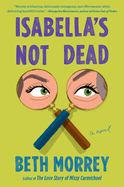
| Publisher: | Putnam | |
| Genre: | Women, Family Life, General, Literary, Fiction | |
| ISBN: | 9780593540336 | |
| Pub Date: | August 2025 | |
| Price: | $29 |
| Starred | Fiction |
by Beth Morrey
Isabella's Not Dead by Beth Morrey (The Love Story of Missy Carmichael; Delphine Jones Takes a Chance) is a darkly funny novel about friendship, reinvention, and the strange limbo of midlife. Gwen Mortimer, 53, is feeling increasingly invisible. Her children are becoming more self-reliant, she's lost her job, and even her podcasting husband, Angus, seems more engaged with his microphone and his beloved dog than with her.
When a reunion of her secondary school's hockey team highlights the absence of her former best friend, Isabella, whom no one has been able to contact in 15 years, Gwen seizes on a new purpose: to find out why Isabella ghosted them. Although some of their teammates think she must have died, Gwen is certain that Isabella's not dead--even if a Ouija board seems to be sending messages that suggest otherwise.
What follows is a heartfelt and often hilarious journey across England, Scotland, and Italy, as Gwen tracks down Isabella's family, colleagues, and other friends. Along the way, she uncovers not only clues to Isabella's vanishing act but also long-buried truths about herself.
Morrey's wise writing is laced with a wry humor that captures the absurdities of aging, marriage, and memory. Gwen's relationships with her gangly sons and her difficult mother-in-law are sharply observed. But what truly sets Isabella's Not Dead apart is Morrey's nuanced examination of how friendships can shift, fracture, and sometimes disappear entirely--and how that loss can shape people just as much as love. --Jessica Howard, former bookseller, freelance book reviewer
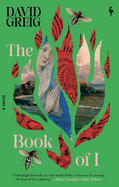
| Publisher: | Europa Editions | |
| Genre: | Friendship, Medieval, World Literature, Scotland - General, Nature & the Environment, Humorous, Christian, General, Literary, Fiction, Historical, Sea Stories | |
| ISBN: | 9798889661276 | |
| Pub Date: | September 2025 | |
| Price: | $24 |
| Fiction |
by David Greig
There's bloodshed aplenty when the Vikings go head-to-head with Christians in Scottish playwright David Greig's phenomenal debut historical novel, The Book of I. It's "a good day for a massacre" in the spring of 825 A.D., when Norwegian warrior Grimur arrives on Helgi Gustafsson's "red-sailed wave horse" at the Christian monastery on the small, remote isle of Iona, a "spit of sea, granite, bog and sand." The brutal Vikings are seeking the silver reliquary of Saint Colm's bones.
Their "satanic butchery" leads to the total destruction of the abbey and the slaughter of 70 monks. In fine Grand Guignol fashion, the abbot refuses to disclose the location of the sacred bones and is drawn and quartered between four ponies; in "five, or maybe eight, minutes, it was over." One young monk, Brother Martin, survives in the privy, up to his knees in urine and excrement. Another survivor is the smith's now-widow, Una, who crafts medicinal mead. Helgi's retinue believe that Grimur has been felled and dig a "quick grave," where Martin discovers him later. And in the aftermath, the trinity of Grimur, Martin, and Una explore love, sacred and profane, creating a found family based on faith, redemption, and community.
Summer slides into fall as Grieg's narrative depicts how the unlikely unit adapts to a newly discovered sense of self. Poetic style tinctured with tragicomedy ("What do you call a Viking without a boat?... Dead.") adds buoyancy to the language and elevates sentences with iambic breeziness and imagery. Despite grim material, Greig leavens this extraordinary novel with dark humor and bristling, lyrical prose. --Robert Allen Papinchak, freelance book critic
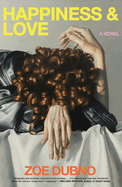
| Publisher: | Scribner | |
| Genre: | Dark Humor, Humorous, Satire, Literary, Fiction | |
| ISBN: | 9781668062951 | |
| Pub Date: | September 2025 | |
| Price: | $27 |
| Fiction |
by Zoe Dubno
In Zoe Dubno's dark and entertainingly splenetic debut novel, Happiness & Love, a nameless narrator spends the length of a dinner party mentally eviscerating her hosts and others who are part of a rarefied world of art, affluence, and narcissism.
The novel opens where it remains: at the Manhattan loft of a wealthy, artistic couple. The narrator, who once lived with the couple, is a writer who learned a few days earlier of the drug-overdose death of a mutual friend: "Each and every person at the dinner had been at Rebecca's funeral that day. And yet this was not a dinner in her honor." The party's guest of honor is an actress whose arrival everyone spends the book's first half anticipating. During this time, the narrator evaluates her company, whom she regards as corrosive enough to have driven her to spend the previous five years abroad.
Happiness & Love has no chapters or paragraph breaks; it's one continuous skein of invective. (In an afterword, Dubno says the book is loosely based on Austrian writer Thomas Bernhard's 1984 novel, Woodcutters.) As the narrator mentally throws her barbs, many hilarious and most in the direction of her hosts (one is "a self-involved predacious remora"), readers will gradually come to understand that Happiness & Love is a grief novel spiked with guilt. In one of her rare guileless moments, the narrator notes that, "had I not abandoned Rebecca, had I not condemned her for her weakness, she may have been here at the Bowery tonight instead of me." --Nell Beram, author and freelance writer
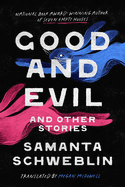
| Publisher: | Knopf | |
| Genre: | Psychological, Short Stories (single author), Literary, Fiction | |
| ISBN: | 9780593803103 | |
| Pub Date: | September 2025 | |
| Price: | $27 |
| Fiction |
by Samanta Schweblin, trans. by Megan McDowell
Celebrated Argentinian author Samanta Schweblin and translator Megan McDowell, who co-won the 2022 National Book Award for Translated Literature for Seven Empty Houses, reunite for their fifth collaboration, Good and Evil and Other Stories, an exceptional six-story collection. Despite the seemingly simple title, little of Schweblin's fiction is ever quite straightforward; her perplexingly peculiar, uncannily startling narratives are poised to delight and challenge.
Complicated, strained relationships between family members repeat and resonate here. In "An Eye in the Throat," a young child loses his voice (and almost his life) after swallowing a battery, but his father is the one who loses his ability to communicate his stifling guilt and desperate love for his son. When Schweblin adds animals to her narratives, inexplicable and mystical events occur. In "Welcome to the Club," a woman struggles between her life with a husband and two daughters (and a borrowed, escape-prone rabbit) and the lure of the mossy bottom of the nearby open water. In "William in the Window," a Shanghai writers' residency gathers an internationally diverse group of 10 authors; when they congregate one evening for the Irish writer's birthday, they also share in the news of the death of her cat.
Schweblin (Mouthful of Birds) again demonstrates her irrefutable mastery for arousing unease, always eschewing easy labels or judgments. Her ending "Notes on the Stories" is a delicious enhancement. To bestow "good" or "evil" verdicts on any of her characters--or their unsettling situations--is a purposefully impossible task, a dazzling reminder that the gray areas of in-between are where realities exist. --Terry Hong
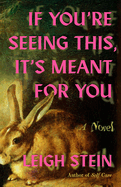
| Publisher: | Ballantine | |
| Genre: | Women, Dark Humor, Psychological, Humorous, Satire, Gothic, Fiction | |
| ISBN: | 9780593983645 | |
| Pub Date: | August 2025 | |
| Price: | $18 |
| Fiction |
by Leigh Stein
Gothic mystery collides with the social-media age in Leigh Stein's roller-coaster of a novel, If You're Seeing This, It's Meant for You. The gothic mansion here is a deteriorating Los Angeles architectural landmark serving as a hype house for social-media influencers. Dayna, in the wake of an embarrassingly public breakup that plays out on Reddit, reluctantly agrees to manage the house despite her complicated past with it and its owner.
Part of Dayna's motivation to return is curiosity about the disappearance of the house's most popular influencer, a tarot reader named Becca. This curiosity is shared by the other residents of the house, so they all decide to investigate in the way they know best: a social-media campaign dramatizing the search.
The setting is delightfully unnerving, populated by characters with both ridiculous and relatable foibles. This includes Jake, who plumbs his many charms to cater to his target demographic of middle-aged female followers, and Olivia, an orphan with a "tragic past," who posts a lot of crying content but is genuinely haunted by guilt over her parents' deaths. They all come together to create a novel that's funny, horrifying, and eerily insightful.
Stein (Land of Enchantment; Self Care) deftly mixes uncanny creepiness with the absurdity of social-media jargon. When one of the characters becomes increasingly untethered from reality, comparing herself to obscure biblical references, another says, "I don't know what that is, but I think you're experiencing burnout, which is extremely common." The novel's deadpan humor, combined with the sharp commentary on the strange psychic damage of living lives online, makes for an enthralling read. --Carol Caley, writer
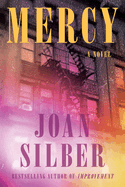
| Publisher: | Counterpoint | |
| Genre: | Friendship, Family Life, General, Literary, Coming of Age, 20th Century - General, Fiction, Historical | |
| ISBN: | 9781640097070 | |
| Pub Date: | September 2025 | |
| Price: | $27 |
| Fiction |
by Joan Silber
Who would turn down a show of leniency? Certainly not the characters in Joan Silber's Mercy. That some of them get it and some of them don't adds to the complexity of this work, which contains multiple protagonists and cleverly interlocking stories. The novel has two fulcrums, one of which is the New York City emergency room that otherwise unrelated characters have the misfortune to need. In the first set of stories, it's 1973, and Ivan and Eddie are longtime pals whose adventures are dominated by hardcore drug use, predominantly heroin. As Ivan puts it, "My true home was where my beloved substance was." When Eddie overdoses, Ivan rushes his unconscious friend to the ER, only to take off into the January night and leave him stranded.
At the same time, 10-year-old Cara slips on a snowy fire escape outside her apartment and has to go to the same ER because she has "broken and splintered [her] tibia in a fairly major way." Part of the richness of this novel is the way Silber (Secrets of Happiness) deepens these stories, from Eddie's actress girlfriend, who goes on to a successful if turbulent Hollywood career, to Cara's friend Nini, who attends grad school for anthropology and gets a choice fieldwork assignment thanks to the married British professor she's sleeping with. All of which leads to the novel's second fulcrum: the concept of forgiveness in all its manifestations. It all gets quite complicated, just like the notion of mercy itself, but the result is this elegantly rewarding work. --Michael Magras, freelance book reviewer
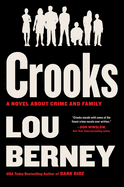
| Publisher: | Morrow | |
| Genre: | 20th Century - Post-World War II, Sagas, Family Life, Crime, Literary, Suspense, Thrillers, Fiction, Historical, Siblings | |
| ISBN: | 9780063445574 | |
| Pub Date: | September 2025 | |
| Price: | $30 |
| Fiction |
by Lou Berney
Spanning half a century, Crooks by literary crime writer Lou Berney (Double Barrel Bluff; The Long and Faraway Gone) examines the criminal tendencies of one family in a novel that is as much a character study as it is an adventure through various demimondes of the United States.
Crooks begins in the shiny new mob-controlled Las Vegas of the early 1960s, where low-level gangster Buddy Mercurio falls in love with Lillian Ott, a beautiful petty thief. The two marry, have children, and continue to hustle until a death threat forces them to skip town and move to Oklahoma. There, Buddy opens the first disco in the state and makes a killing, not least from the funds he skims off the top. The narrative then shifts to the five Mercurio children and examines the ways in which their criminal DNA influences their lives. Jeremy, the favorite son, becomes a well-paid gigolo in 1980s Hollywood; Tallulah gets involved in human trafficking in 1990s Moscow; Ray, a mob muscle man in Las Vegas, attempts to leave violence behind; Alice, considered the family's genius, fails in her attempts to stay clean in her work at an East Coast law firm; and Piggy, the youngest, documents the family saga as a writer.
Berney's trademark humor and insight into the human condition are on display here as the Mercurios find themselves caught in both perilous situations and moral dilemmas while they struggle to reconcile family loyalty with a life on the straight and narrow. Despite their failings, the Mercurios are relatable, even charming, and they make Crooks an engaging and lively read. --Debra Ginsberg, author and freelance editor
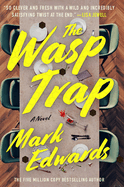
| Publisher: | Atria | |
| Genre: | Psychological, Suspense, Thrillers, Fiction | |
| ISBN: | 9781668204771 | |
| Pub Date: | September 2025 | |
| Price: | $29 |
| Mystery & Thriller |
by Mark Edwards
The Wasp Trap is an absolutely thrilling, tautly plotted puzzle of a novel by Mark Edwards. The first timeline of this double-locked-room mystery takes place in July 1999. A group of recent college graduates are gathered at a country estate outside London by a charismatic psychology professor to work around the clock on a dating website. In truth, they also work at developing a test to identify psychopaths (their mentor's first interest). "The lothario. The salesman. The affluent couple, the joker and the local girl. Finally, me, the wordsmith, whose role was to write it all down. If any of us were a psychopath, I already had a good idea who it would be." The bulk of the novel is narrated by Will, an aspiring writer who often feels trapped on the outside.
Twenty-five years later, to commemorate the death of their former employer, the "affluent couple" of the original project hosts their old friends for a lavish dinner party in their high-security Notting Hill townhouse. But immediately the evening shifts from awkward to nightmarish, part home invasion and part sinister game. The group is commanded to reveal a secret from the storied summer of '99. Each dinner guest denies knowing what information is sought, but each, of course, does harbor secrets. The once tight-knit group fractures amid secret and not-so-secret sexual tensions, financial pressures, and old jealousies, especially with a suspected psychopath or two in their midst.
Offering twists and turns and surprises through his novel's final pages, Edwards executes a highly satisfying thriller with this intriguing blend of terror and nostalgia for youth and freer, more hopeful times. --Julia Kastner, blogger at pagesofjulia
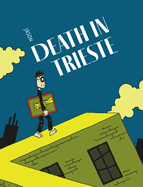
| Publisher: | Fantagraphics | |
| Genre: | Humorous, Magical Realism, Literary, Comics & Graphic Novels | |
| ISBN: | 9798875001253 | |
| Pub Date: | September 2025 | |
| Price: | $24.99 |
| Graphic Books |
by Jason
Ziggy Stardust-era David Bowie appears as either an image or a character in all three black-and-white graphic stories that make up Death in Trieste by mononymous Norwegian Eisner Award winner Jason (The Left Bank Gang; I Killed Adolf Hitler). That Bowie, like most of the book's characters, is a human-animal hybrid is one of the less strange aspects of this pleasingly odd endeavor.
In "The Magritte Affair," a crime story largely set in Brussels, a couple of burglars steal a portrait of Ziggy Stardust from a house and leave in its place what looks like surrealist painter René Magritte's The Son of Man. In the more languid "Death in Trieste," set in 1925 Berlin, a time-traveling Bowie's encounter with Marlene Dietrich is just one storyline revolving around characters who embrace Dadaism (someone explains the concept to an uninitiated Bowie). And in "Sweet Dreams," an asteroid is headed toward London. (Bowie is, fittingly, in outer space in this story.) Possibly in the asteroid's path are members of 1980s musical acts Eurythmics and Ultravox, as well as other famous faces from the era's British music scene.
Throughout Death in Trieste, Jason uses spare and lean black lines on stark white; the book may contain some challenging ideas, but he gives readers plenty of neutral space to get their bearings. Everything here is marvelously surreal and silly, with much superhero-comics-style fighting ("BAM") and the occasional metafictional touch, as when one character in "The Magritte Affair" describes another as "the hat seller from page 14, panel 2!" --Nell Beram, author and freelance writer
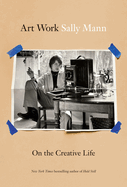
| Publisher: | Abrams Press | |
| Genre: | Biography & Autobiography, Photography, Self-Help, Art, Individual Artists, General, Memoirs, Individual Photographers, Essays, Creativity | |
| ISBN: | 9781419780714 | |
| Pub Date: | September 2025 | |
| Price: | $35 |
| Starred | Biography & Memoir |
by Sally Mann
Fifty years in the trenches of the art world thickens the skin and teaches a lot of lessons. American photographer Sally Mann (Hold Still) imparts some of that wisdom in Art Work, an appealingly edgy memoir that mixes sage advice with irreverent prose. This book, "written by an old woman primarily for young artists and writers," is meant to help them "avoid some of the pits into which I fell." To that end, she focuses not on her work but "the other things that both buttress the art-making life and hinder it," including constant distractions and the need for a support network. It's a book, Mann writes, about "how to get shit done."
With this volume, Mann has given young artists a gift that is neither pessimistic nor Pollyannaish. She acknowledges the role of talent, but she's forthright about the need for good luck, as when the man next to her on a plane in the 1970s just happened to be a wealthy jeweler who "believed in my work way before I did" and ultimately gave her a much-needed grant. More advice follows, such as the importance of being organized and the best ways of handling rejection. And any artist who thinks they're uniquely plagued by hindrances should read the story of the trailer Mann bought as an artist's retreat and the tenants from hell who rented it. "Somehow, despite all the distractions and the despair, art gets made," Mann writes. Artists will reach the same conclusion after reading this iconoclastic book. --Michael Magras, freelance book reviewer
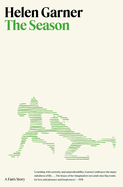
| Publisher: | Pantheon | |
| Genre: | Biography & Autobiography, Family & Relationships, Parenting, Cultural & Social Aspects, Sports & Recreation, Grandparenting, Memoirs | |
| ISBN: | 9780593702147 | |
| Pub Date: | September 2025 | |
| Price: | $26 |
| Biography & Memoir |
by Helen Garner
Sports fans will find much to relate to in The Season, a memoir from Australian novelist Helen Garner (The Children's Bach; How to End a Story). At 80, "the age at which my mother died demented," Garner needed hearing aids and was losing her eyesight but loved being "a hands-on nanna who by some unimaginable miracle was invited to buy the house next door, knock down the fence, and become part of family life." She wanted to become better acquainted with her 15-year-old grandson, Amby, who played Australian football, or footy, as it's known. She asked him if she could attend his training sessions and matches. He agreed. So, with a "brand-new notebook hidden in the back pocket of my overalls," she penned her observations from the sidelines during the seven-month season.
The result is this tender book, a "record of a season we are spending together before he turns into a man and I die." Fans of Garner's work will recognize familiar elements, from the spare prose to doubts about her writing, as when she asks, regarding this memoir, "Am I wasting my time?" Although one's appreciation for the book may be enhanced by familiarity with Australian football, laypeople will still respond to the emotions on display, such as teenager Amby's frustrations with romance and, most prominently, Garner's concern for his safety, such as when she sees players smashing into each other, including a head butt that "makes me sick to my stomach," looks at muscular Amby, and thinks, "I wish he could be bulletproof." Fans of families will understand. --Michael Magras, freelance book reviewer

| Publisher: | St. Martin's Press | |
| Genre: | Biography & Autobiography, Women, Women in Sports, Sports & Recreation, Memoirs, Running & Jogging | |
| ISBN: | 9781250344946 | |
| Pub Date: | September 2025 | |
| Price: | $30 |
| Biography & Memoir |
by Keira D'Amato, with Evelyn Spence
Distance runner Keira D'Amato's upbeat memoir, Don't Call It a Comeback, chronicles her physical and mental journey as an athlete, from her early years as a cross-country star to her unconventional pro career after becoming a mother. With honesty, heart, and plenty of humor, D'Amato encourages readers to go after their dreams while also pursuing joy, noting, "I was chasing happiness, but happiness was the chase."
D'Amato begins with "Round One," the years she spent as a top-notch runner in high school and college, which ended after she sustained several injuries. After marriage, motherhood, and a real estate career, D'Amato tried running again, building her fitness from scratch. Slowly, with the help of her marathon-runner husband and her community, she began racing again--this time for fun.
As she charts the miles she's covered in her roles as a military wife, real estate professional, and athlete, D'Amato repeatedly urges readers to find satisfaction in the goals they're pursuing, even when hard effort is called for. She writes frankly about her bad days, including the gut-wrenching experience of stepping off the course during the 2024 Olympic trials. D'Amato is no stranger to self-doubt, disappointment, and other tough emotions, but she believes (and insists) that playfulness and fun are possible--and necessary--even in difficult times.
Filled with entertaining anecdotes and heartfelt tributes to D'Amato's teammates, coaches, and loved ones, Don't Call It a Comeback is an inspiring yet practical account of running happy--and, yes, running fast. --Katie Noah Gibson, blogger at Cakes, Tea and Dreams
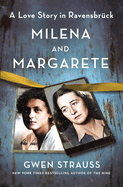
| Publisher: | St. Martin's Press | |
| Genre: | Women, Biography & Autobiography, Wars & Conflicts, General, 20th Century - Holocaust, History, World War II - General, Modern, LGBTQ+ | |
| ISBN: | 9781250285744 | |
| Pub Date: | August 2025 | |
| Price: | $29 |
| History |
by Gwen Strauss
In Gwen Strauss's novel-like Milena and Margarete, two remarkable women endured the horrors of a concentration camp together while falling deeply in love. In an "act of recovery and imagination," Strauss (The Nine) gives this multilayered account of the forbidden "passionate friendship" between the German Margarete Buber-Neumann and the Czech journalist Milena Jesenská, who first met as political prisoners in the all-female Ravensbrück concentration camp in 1940. Connecting over their shared experience of disillusionment with the Communist Party, they began exchanging letters and meeting for brief walks near the camp's high wall, nicknamed "the Wailing Wall," that had electrified wires on top.
Strauss confronts history's silence on these taboo female relationships by "reading between the lines" of Buber-Neumann and Jesenská's experience, piecing together Buber-Neumann's later writings to conclude that the two shared a "physical, tender, and profound" love. Strauss juxtaposes the women's moments of light and hope (they planned to write a book together after the war) with the painful refrain of suffering, torture, and death at the hands of Nazi camp officials. The novelistic dialogue Strauss employs to dramatize conversations is the "imagination" half of the narrative's recovery, but it is affecting, nonetheless. For four years, "they had built their little world together inside" a place of hellish torment; indeed, "to have found love in a concentration camp is extraordinary." Milena and Margarete is a heartrending story of love in an impossible place that also gives voice to the hidden stories of women loving women. --Peggy Kurkowski, book reviewer in Denver
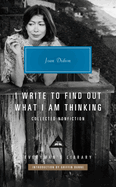
| Publisher: | Everyman's Library | |
| Genre: | Women Authors, Literary Criticism, Journalism, Literary Collections, Language Arts & Disciplines, Essays | |
| ISBN: | 9780593992210 | |
| Pub Date: | September 2025 | |
| Price: | $35 |
| Essays & Criticism |
by Joan Didion
Joan Didion (1934-2021) wrote two justifiably celebrated grief memoirs: The Year of Magical Thinking (2005), prompted by the 2003 death of her husband, writer John Gregory Dunne, and its tragic companion, Blue Nights (2011), about the 2005 death of their daughter. I Write to Find Out What I Am Thinking packages those memoirs with two lesser-known titles, fusing the last four books Didion published in her lifetime into one meaty compendium.
South and West: From a Notebook (2017) features two pieces no less interesting for their incompleteness. "Notes on the South" offers Didion's observations gathered during a 1970 road trip around the southern United States ("The Civil War was yesterday, but 1960 is spoken of as if it were about three hundred years ago"). "California Notes" collects her 1976 jottings about fellow Golden State daughter Patty Hearst; these abandoned notes would seed Didion's 2003 memoir, Where I Was From.
Let Me Tell You What I Mean (2021) is manna for fans of Journalist Joan. The book's 12 essays include two pieces written decades apart that capture the evolution of Didion's profile work. Whereas stalactite-sharp objectivity guides 1968's "Pretty Nancy," about then first lady of California Nancy Reagan, Didion plays her hand in 2000's "Everywoman.com," about another much-mocked public figure: Martha Stewart "has branded herself not as Superwoman but as Everywoman, a distinction that seems to remain unclear to her critics."
Only one thing links the thematically disparate books bundled here: Didion's exacting sentences, so well preserved that they seem to have been set on ice. --Nell Beram, author and freelance writer
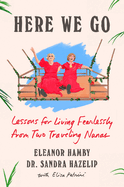
| Publisher: | Viking | |
| Genre: | Self-Help, Personal Growth, Travel, Happiness, Inspiration & Personal Growth, Body, Mind & Spirit, Aging, Essays & Travelogues | |
| ISBN: | 9780593832301 | |
| Pub Date: | September 2025 | |
| Price: | $29 |
| Body, Mind & Spirit |
by Eleanor Hamby, Dr. Sandra Hazelip, with Elisa Petrini
In their early 80s, longtime best friends Eleanor Hamby and Dr. Sandra Hazelip became Internet famous as the "TikTok Traveling Grannies." But they had already been traveling together--on a budget and to various far-flung locations--for years. In their warmhearted joint memoir, Here We Go, Hamby and Hazelip chronicle their 2023 round-the-world journey (undertaken in 80 days, in tribute to Jules Verne) and share the story of their enduring friendship and their advice for approaching the world with curiosity, openness, and joy.
Hailing from modest backgrounds in Texas and Oklahoma, Hamby and Hazelip initially met through a medical mission center in Zambia, cofounded by Hamby's late husband, Kelly. After her own husband's death, Hazelip also became involved with the mission, and the women became close friends. Their shared love of travel--and affection for trains--led to their first journey together, on the Trans-Siberian Railway, and subsequently to many others. Here We Go includes highlights from their numerous travels (the moai of Easter Island, the tango culture of Buenos Aires, even a trip to Antarctica). Their shared philosophies of companionship and travel are: say yes to new experiences, be flexible when circumstances change, and assume the best in people (but use your wits). This mindset has opened doors (literal and otherwise) across the world and resulted in memorable encounters, new relationships, and even--to the authors' surprise--media fame. For readers looking for unusual travel inspiration or practical friendship advice, Here We Go is a wise, entertaining guide to seeing the world with fresh eyes and an open heart. --Katie Noah Gibson, blogger at Cakes, Tea and Dreams
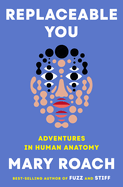
| Publisher: | W.W. Norton | |
| Genre: | Life Sciences, Surgery, Cosmetic & Reconstructive, Science, Human Anatomy & Physiology, Medical, Regenerative Medicine, Transplant | |
| ISBN: | 9781324050629 | |
| Pub Date: | September 2025 | |
| Price: | $28.99 |
| Starred | Science |
by Mary Roach
With books like Gulp: Adventures on the Alimentary Canal, Mary Roach has earned a well-deserved reputation for delivering useful scientific information to a general readership with impressive style and wit. She continues on that path with Replaceable You: Adventures in Human Anatomy, a lively survey of the state of the art in the field of regenerative medicine--a collection of disciplines that, in the aggregate, function as the equivalent of a human auto body shop.
Each of Replaceable You's chapters focuses on a discrete body part or system, such as hair follicles and the rectum. With Roach as an inquisitive, intelligent guide, readers learn about topics like the evolution of the technology for joint replacements. Roach isn't afraid to step out from behind her computer and observe cutting-edge research up close. Among other places, her travels took her to Sichuan, China, where researchers are working to overcome traditional Chinese reluctance to donate organs by exploring ways of adapting pig organs to human beings, and to a clinic in Tbilisi, Georgia, attempting to track down a doctor who uses fingers for penis transplants.
In the chapter on fashioning a vagina out of a colon, Roach comments on the "remarkable and sometimes surreal adaptability--the agreeableness--of the human body." But as she cautions in her chapter on 3D printed organs, citing Carnegie Mellon biomedical engineer Adam Feinberg, when it comes to implanting entire functional bioprinted organs in patients, we are "somewhere around the Wright brothers stage." Despite that caveat, anyone interested in an informative, entertaining exploration of the fast-moving developments in these fields will enjoy taking that trip with Mary Roach. --Harvey Freedenberg, freelance reviewer

| Publisher: | St. Martin's Press | |
| Genre: | History & Criticism, Rock, Music, Genres & Styles, General, Popular Culture, Social Science | |
| ISBN: | 9781250363381 | |
| Pub Date: | August 2025 | |
| Price: | $29 |
| Performing Arts |
by Chris DeVille
The popularity of "college rock" or "alternative rock" exploded after the turn of the 21st century, further blurring the lines between commercial music and the independent rock music scene that had formed a countercultural identity for so many of its ardent listeners. Chris DeVille, who is now the managing editor at Stereogum, grew up in the heart of that scene and is perfectly and passionately positioned to describe its evolution in the fun and comprehensive Such Great Heights.
DeVille's personal narrative is the engine of the book, which takes readers through his transformation from a teenage fan poring over liner notes to a prominent voice in the music journalism world. He paints a vibrant picture of the transition from the scrappy days of early-aughts music blogs and nascent social media, when a single post could launch a band into the stratosphere, to the fractured and data-driven landscape of modern streaming services. "The harder it got for bands to make a living through traditional means like selling records and going on tour, the less of a scandal it became to license your music for commercial purposes."
The book's title is, of course, a nod to the 2003 hit record by indie royalty band the Postal Service. DeVille uses the song to encapsulate the era's blend of earnest emotion and electronic sheen. He charts the rise of an exhaustive list of artists from a dazzling array of overlapping subgenres through the changing intersection of art and commerce that has characterized this century thus far. Such Great Heights is a magnificent read and an inspiration for countless playlists. --Elizabeth DeNoma, executive editor, DeNoma Literary Services, Seattle, WA
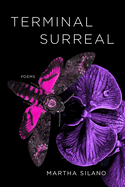
| Publisher: | Acre Books | |
| Genre: | Women Authors, Death, Grief, Loss, Poetry, Subjects & Themes | |
| ISBN: | 9781946724946 | |
| Pub Date: | September 2025 | |
| Price: | $17 |
| Starred | Poetry |
by Martha Silano
Martha Silano's posthumous eighth collection, Terminal Surreal, incorporates science and nature imagery in a mischievous and moving verse account of her final years with ALS.
The shock and sorrow of a terminal diagnosis were eased by the quotidian pleasures of observing Pacific Northwest nature, especially birds: "I open/ my curtains to the crows, to a scrub jay in the maple." Silano (Last Train to Paradise) proposes neologisms for this conjunction of the world's beauty and her ache at leaving it: "WonderPain. MarvelWoe./ WowLoss." Her outlook is reminiscent of Mary Oliver's as she advises, "Kneel at least once a day,/ preferably at dusk, preferably// in front of someone or something that sustains you."
Fascination with science recurs, including "Why I Want to Be a Noble Gas" and a detail of the poet "reading a book about muons, gluons, positrons,/ and quarks." Silano also reflects on her relationships with her children and muses on her legacy. Most pieces are free-form, though there are three abecedarians. Rich alliteration and wordplay enliven the conversational register: "Did you say permission or persimmon? Either way,/ I will be your plankton, what keeps you phosphorescent"; "Grateful for Xanax, cuz what did people do without/ antianxiety meds? Love that it's a palindrome!"
Maintaining a balanced tone, Silano acknowledges her decline and ponders all she'll miss, yet manages to find the humor and ridiculousness in her situation. Her winsome philosophical work is a gift. "What doesn't die?/ The closest I've come to an answer/ is poetry." --Rebecca Foster, freelance reviewer, proofreader and blogger at Bookish Beck
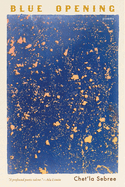
| Publisher: | Tin House | |
| Genre: | American, Death, Grief, Loss, Family, Poetry, Subjects & Themes, African American & Black | |
| ISBN: | 9781963108460 | |
| Pub Date: | September 2025 | |
| Price: | $18 |
| Poetry |
by Chet'la Sebree
In a note to readers at the start of Blue Opening, poet Chet'la Sebree explains that "this collection, which emerged like life from the ether, is for those who, too, scramble and search, who dive into the unknown." Sebree's powerful collection plumbs those depths, each poem an exploration of how things emerge from the unknown, of origins and roots and beginnings. The book's three sections all open with a numbered poem titled "Root Logic," each one an etymological examination of a word: womb, breast, and brain. Though each is a distinct piece, the numbering makes them feel like linked stanzas, uniting the book across their shared form and structure.
Sebree makes creative use of numbering throughout, as seen in "Five Facts About Lupus," where each page features numbered, brief stanzas. In addition to this fragmentation, the poem is further destabilized by its sequence: the predictable (1, followed by 2, followed by 2a) supplanted by the unexpected, where 2a is followed by 1a, and 2d & e chase after 3. This level of care, of attention to the way design and content overlap to create meaning, is what sets Sebree's collection apart, asking readers to give it the same level of careful attention.
The poems revel in a raw physicality, as in the prose poem "Home Remedy" which dances between alliterative phrasing and a gritty reality: "A keratin cord curls itself between pubic hairs still damp from the shower--a single comma curdling out." With her kinetic idea-play and word work, Sebree invites readers to join her, awestruck at all the unknowable wonders and griefs of being human. --Sara Beth West, freelance reviewer and librarian

| Publisher: | Scribble US | |
| Genre: | Concepts, Humorous Stories, Animals, Words, General, Short Stories, Juvenile Fiction | |
| ISBN: | 9781964992150 | |
| Pub Date: | September 2025 | |
| Price: | $18.95 |
| Starred | Children's & Young Adult |
by Silvia Borando, trans. by Felicita Sala
Ten super-pithy, gratifyingly silly stories introduce early readers to the allure of micro-tales, accompanied by droll illustrations in candy-bright colors.
With exquisite comedic timing, Italian author and illustrator Silvia Borando (If I Met a Bear) creates picture book magic by combining a handful of evocative words with simple cartoon illustrations done in black felt pen and colored digitally. Total word-counts for most of the stories in Borando's Short Stories hover around 20. In the first story, which begins and ends before the title page, there is a mostly blank double-page spread in orange and red, depicting a wide sky and an expanse of grass. The next spread has the same backdrop, now inhabited. A big blue carefree-looking elephant, crisply outlined, strolls along on the left side: "Once upon a time there was an elephant." On the right stands a tiny black ant: "and there was an ant." Turning the page, readers see the elephant standing where the ant had been a moment earlier: "'What ant?' asked the elephant. The End." Other stories feature a prickly hedgehog at a birthday party with balloons ("Party's over"), a chatty frog and a bored chameleon, and a snail and a centipede who want to go somewhere... as soon as the centipede puts its shoes on.
Borando's use of three-act structure--a format that includes the classic "Once upon a time," a denouement, and a decisive "The End"--allows young readers to anticipate the humor without guessing the outcome. Translator and author/illustrator Felicita Sala (A Lost Cause) efficiently changes the Italian to English, ensuring that there is not a single excess word in this fun-size collection. --Emilie Coulter, freelance writer and editor
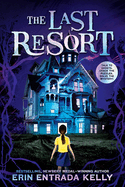
| Publisher: | Scholastic Press | |
| Genre: | Paranormal, Occult & Supernatural, Ghost Stories, Mysteries & Detective Stories, Juvenile Fiction | |
| ISBN: | 9781546132431 | |
| Pub Date: | September 2025 | |
| Price: | $17.99 |
| Children's & Young Adult |
by Erin Entrada Kelly, illust. by Naomi Franquiz
An 11-year-old girl with a tendency toward overreaction begins seeing ghosts in the spooky, spine-tingling middle-grade mystery The Last Resort by two-time Newbery Medalist Erin Entrada Kelly (The First State of Being; Hello, Universe).
Lila Clement is starting seventh grade and struggling with her best friend trio: Lexi and Ava are calling her "childish," "immature," and a "drama queen." Lila is counting on having the summer to solidify their friendship before school starts, but her parents tell her that her estranged grandfather has died and the family needs to go to Ohio. Grandpa Clem ran the small Castle Hill Inn and has left it to her father, so the family will be away for a few weeks to attend the funeral and settle the estate. Lila feels flattened. The family stays at the inn as they struggle to mourn someone they barely knew, and Lila's life becomes distinctly more complicated when she starts seeing ghosts, including Grandpa Clem. She is a "high channel," Grandpa Clem tells her, and he shouldn't be here--"the portal didn't open." He must have been murdered, he tells Lila, and he needs her help.
The Last Resort, intended to be a digitally interactive title, is a fun classic haunted house story in which any ghost may be friend or foe. Ghosts are brought (back) to life through Naomi Ranquiz's brilliant black-and-white character sketches, reminiscent of Tim Burton and Disney's Haunted Mansion. QR codes embedded in the illustrations should allow readers to further explore Lila's world through their devices. [Interactive elements were not reviewed by Shelf Awareness.] First in a multi-authored series, The Last Resort is a delightfully frightful and absorbing mystery. --Kyla Paterno, freelance reviewer
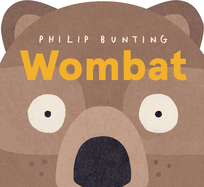
| Publisher: | Charlesbridge | |
| Genre: | Concepts, Humorous Stories, Words, Imagination & Play, Juvenile Fiction | |
| ISBN: | 9781623546595 | |
| Pub Date: | September 2025 | |
| Price: | $8.99 |
| Children's & Young Adult |
by Philip Bunting
Lovable round-faced marsupials take center stage in the cheerful, bouncy board book edition of Wombat by Philip Bunting (The Gentle Genius of Trees).
"Wombat," the first page announces. A cartoonishly wide-eyed version of the thick-bodied, brown-furred animal stands next to a yellow flower. "Twobats," the facing page adds confidently, as the first wombat tries to hand the now-plucked flower to a blushing, identical companion. Unfortunately, a newcomer popping up between them makes "threebats" and causes a slight case of stink-eye in the would-be gifter. More-supials follow, and then the book shifts to play with other concepts: shapes like Squarebat, the aptly named Splatbat, and all three primary colors plus the queasily green Vombat. The story circles back around to conclude the romantic plot when the first pair reunite, the flower finally passing from paw to paw. The charming gift changes their relationship status from "likebat" to "lovebat," a development that culminates in a tiny, diapered mini-bat with a single curled hair sprouting from its chubby-cheeked noggin.
Bunting's expressive characters have no visible mouths themselves but make smiles an easy proposition for the reader. The spare, rhythmic text will rock grownups and littles through multiple rereads and could become a chant to know by heart. The book's form factor leans all the way into its topic with pages die-cut into the shape of the titular animal's face, earning extra adorability points for presentation. Adults with toddlers should keep this sweet, silly romp-bat in their pouches for quick giggles. --Jaclyn Fulwood, youth services manager, Allen County Public Library
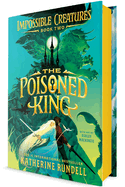
| Publisher: | Knopf Books for Young Readers | |
| Genre: | Dragons, Unicorns & Mythical Creatures, Survival Stories, Fantasy, General, Juvenile Fiction, Action & Adventure | |
| ISBN: | 9780593809907 | |
| Pub Date: | September 2025 | |
| Price: | $19.99 |
| Children's & Young Adult |
by Katherine Rundell, illust. by Ashley Mackenzie
The Archipelago must once again be saved in The Poisoned King, a high-energy and imaginative sequel to Katherine Rundell's beloved Impossible Creatures.
When a tiny dragon summons Christopher Forrester back to the magical world he left a year earlier, it is not for joyous occasions: "The great dragons are dying in their dozens. Nobody knows why." Christopher arrives on the Archipelago's shores and is informed by a sphinx friend that his destiny is linked to that of Anya Argen, reluctant princess of the island of Dousha and friend to the talkative royal gaganas (miracle-working birds from Russian folklore). Anya, however, is fleeing her home--her uncle poisoned her grandfather, pinned the crime on her father, and attempted to murder Anya herself in a bid to steal the throne. The death of the dragons and the murder of Anya's grandfather are connected, but if the children don't figure out the antidote to the poisons used in all the murders, the creatures of the Archipelago may be doomed.
Rundell expertly shapes another magical adventure in The Poisoned King. Though only the first few chapters are through Christopher's point-of-view and not much of the world originally explored in Impossible Creatures appears, many favorite side characters return; the Archipelago is made both familiar and fresh in the eyes of its heroine, a rageful, fearsome girl who chooses kindness over harsh revenge. Fine-lined black-and-white illustrations by Ashley Mackenzie give face to the fantastical creatures and elements in Rundell's imaginative world.
Fans of Impossible Creatures and of stories like Philip Pullman's The Golden Compass will likely be deeply enchanted by this return to the Archipelago. --Nicole Brinkley, bookseller and writer